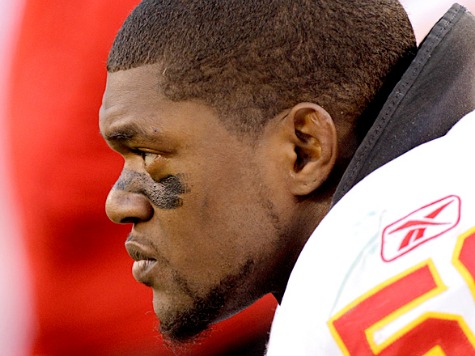Last year’s football media meme mated with this year’s to produce pack journalism’s dream child.
“It’s more than fair to ask if the NFL’s two most troubling issues, domestic violence and head trauma, are linked,” writes Time‘s Sean Gregory.
The purported discovery of chronic traumatic encephalopathy (CTE) in the bullet-obliterated and decomposing brain of Jovan Belcher–a post-burial postmortem conducted at the behest of Belcher’s family suing the Kansas City Chiefs–serves as the impetus for the article. Belcher killed the mother of his child shortly before killing himself on December 1, 2012. The mother of the man-child who killed that mother ordered the exhumation of his corpse a year after his burial.
The Time headline “Are NFL Head Injuries Causing Domestic Violence?” ignores the research–both about CTE and domestic violence–that undermines the premise of the question (certainly intended to answer itself). No studies exist telling us the prevalence of CTE among football players or athletes or even everyday people. The studies that exist on domestic violence and NFL players show significantly lower arrest rates for players than the societal norm.
The statistics blog FiveThirtyEight.com compared NFL domestic violence arrests with those from the peer group in the surrounding society. Nate Silver’s website found that the arrest rate of NFL players for domestic violence actually stands at a little over half that for the comparable demographic outside of the league.
Fifteen years ago, an article in the statistics magazine Chance made a similar discovery. “NFL [crime] rates are less than half the general population rates.” The piece informed that this lower-than-normal arrest rate held for domestic violence. The Chance authors divulged that “even though our initial assessment was that the NFL rates looked very high, we find them well below the rates for the general population.”
Surely Time‘s editors would recognize the idiocy of such a question as, “Are NFL head injuries decreasing domestic violence?” Yet the premise behind their headline’s question reads as even dumber than that one. Though domestic violence committed by celebrity athletes generates more coverage, and infuriates the public more because of the physical prowess of the perpetrators, the happy reality shows that such incidents happen less among millionaire athletes than they do among the Average Joes cheering them from the grandstand.
Just as the article’s premise that NFL players abuse women at inflated rates clashes with the statistics, its second implied premise–that CTE afflicts NFL players at abnormally high levels–doesn’t mesh with the statistics. This is because no statistics exist. Not a single study has been attempted to establish the prevalence of CTE in NFL players or to determine the malady’s cause.
Here’s what the Consensus Statement from the 4th International Conference on Concussion in Sport said:
CTE represents a distinct tauopathy with an unknown incidence in athletic populations. It was further agreed that a cause and effect relationship has not yet been demonstrated between CTE and concussions or exposure to contact sports. At present, the interpretation of causation in the modern CTE case studies should proceed cautiously. It was also recognized that it is important to address the fears of parents/athletes from media pressure related to the possibility of CTE.
The experts in sports medicine don’t know what causes CTE. They don’t know its prevalence among football players. And they acknowledge that “media pressure”–this Time article comes to mind–stokes public fear.
Neither longitudinal nor cross-sectional research on CTE exist. Instead, we have anecdotes. A “selection bias” pollutes that pool of data. In almost every case when a family has asked a brain bank to conduct a postmortem, the family has done so in response to cognitive maladies suffered by the decedent late in life. Predictably, doctors looking at deceased players who suffered from mental problems while alive find brain problems upon autopsy.
Far more troubling than the selection bias among the donated brains is the selection bias among the brain doctors. Increasingly, families donating player brains for study possess a financial incentive–Belcher’s family pursues a civil suit against the Kansas City Chiefs–to obtain a characterization of the brain as diseased. Given that the main groups studying the disease don’t agree on a clinical definition, and, unsurprisingly, diverge wildly in the percentage of brains they identify with the condition, what one doctor calls “CTE” another doctor won’t.
Of course, nonexistent data on CTE and rather convincing data showing reduced partner abuse by NFL players doesn’t buttress the theory that head injuries on the field lead to domestic violence off of it. Time claims, “A link between the NFL’s most troubling issues is far from implausible.” The guys in labcoats do certainty well. Plausible? That’s speculation, not science.

COMMENTS
Please let us know if you're having issues with commenting.